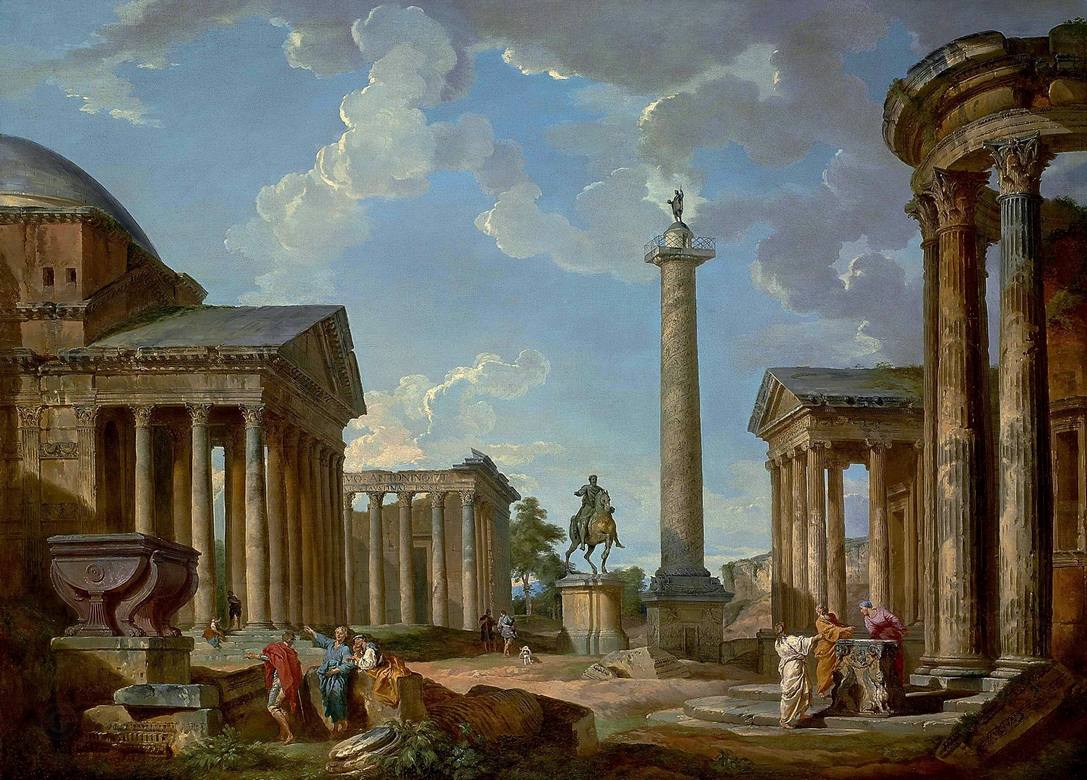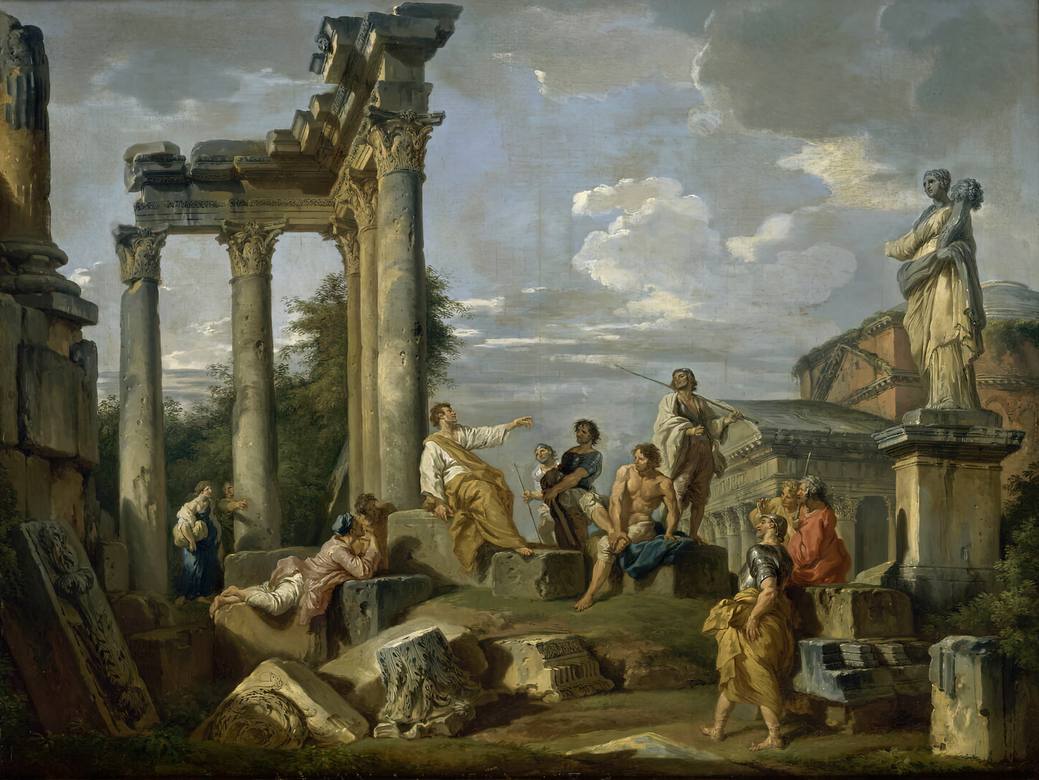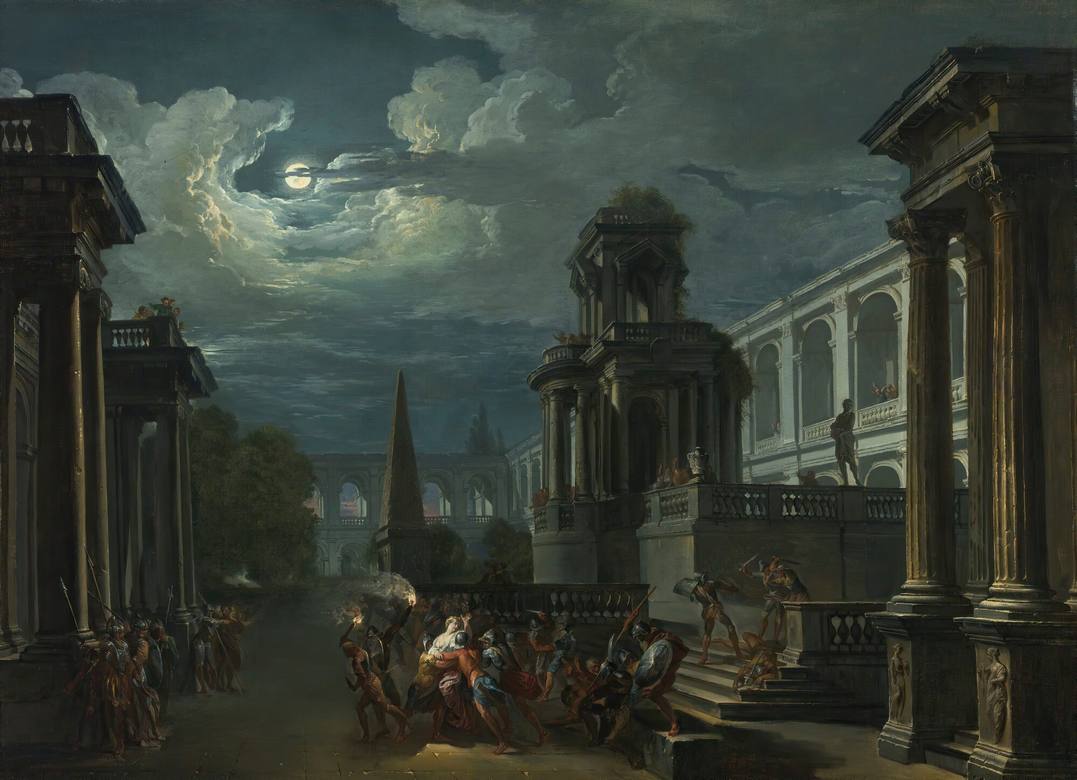
Mythological paintings
and Capricci
Giovanni Paolo Panini paints Rome, its History and Monuments
Panini would mix the magic Aestetic of Rome in recreating the Mythology situations that were related - or could have been related - to Rome's History, mixing up religious situations with ancient Rome atmosphere.
How historically accurate these representations could have been was not important for Panini and his buyers, as much as the "feeling of the old times" could be experienced in the final paintings to create enough interest to buy it.
But the magic is there, no doubt about it, even since his career's beginnings.
Canaletto's early interest in "Mythological images" and "Capricci" paintings also could be the result of Panini's example, for sure the magical aestetic of the Rome of that time, so real and so present, may have had an impact on Canaletto's young mind.
Giovanni Paolo Panini worked taking advantage of the "Grand Tour", the flux of rich tourist visiting Italy for its Artistic side.
Italian painters of the XVIIth century could finally detach their interest & work from the Roman Church assignments, the big and sometimes almost only sponsor in the previous century, Caravaggio Docet.
Thanks to this constant flux of tourists, and thanks to the trend of collecting paintings to decorate and show off in their houses in England, France, Germany and Holland.
An interesting point: since some Giovanni Paolo Panini paintings are presently recognized as being the authorship by "Panini and Workshop" we can assume he had put together a Painting Factory in which he and his assistants were taking care of the production.
![Giovanni Paolo Panini: [ca. 1718-19] - Alexander the Great Cutting the Gordian Knot - Oil on canvas - The Walters Art Museum, Baltimore, MD](../images_db/Giovanni-Paolo-Panini-1718-19ca--gpp113-Alexander_the_Great_Cutting_the_Gordian_Knot__Walters_37516-gp-dlp.jpg)

![Giovanni Paolo Panini: [1717] - Ruins of a Triumphal Arch in the Roman Campagna - Oil on canvas - Detroit Institute of Arts](../images_db/Giovanni-Paolo-Panini-1717--gpp058-Ruins_of_a_Triumphal_Arch_in_the_Roman_Campagna__89.20__Detroit_Institute_of_Arts-gp1_dlp.jpg)
![Canaletto: [1720-21] - Veduta ideata com rovine romane - Oil on canvas - Private Collection](../images_db/Canaletto_1720-21__p307_ni-1-Veduta-ideata-con-rovine-romane--gp1.jpg)
![Canaletto: [1721] - Veduta ideata con rovine romane in riva al mare - Oil on canvas - Private Collection - Collezione V. Cini](../images_db/Canaletto_1721__p310_CR_005_Capriccio_con_rovine_romane_e_figure_d8f947a8-01-gp.jpg)

![Giovanni Paolo Panini: [1740] - Roman forum - Oil on canvas - Pushkin Museum of Fine Arts, Moscow](../images_db/Giovanni-Paolo-Panini-1740--gpp064-Roman-forum-Pushkin-Museum-of-Fine-Arts-Moscow-6961-gp1_dlp.jpg)

![Giovanni Paolo Panini: [ca. 1718] - Adoration of the Magi - Oil on canvas - Harvard Art Museums](../images_db/Giovanni-Paolo-Panini-1718ca--gpp111-Adoration_of_the_Magi__1943.1346__Fogg_Museum-gp-dlp1.jpg)
![Giovanni Paolo Panini: [1738] - Cumaean Sibyl prophesied the Birth of Christ - Oil on canvas - Pushkin Museum of Fine Arts, Moscow](../images_db/Giovanni-Paolo-Panini-1738--gpp144-Cumaean-Sibyl-prophesied-the-Birth-of-Christ--Pushkin-Museum-of-Fine-Arts--DE78FY-gp1-dlp3.jpg)
![Giovanni Paolo Panini: [1740] - Imaginary Landscape with Roman Ruins - Oil on canvas - Columbia Museum of Art, Columbia, SC](../images_db/Giovanni-Paolo-Panini-1740--gpp051-Imaginary-Landscape-with-Roman-Ruins--Columbia-Museum-of-Art-gp.jpg)
![Giovanni Paolo Panini: [1730] - Architectural Capriccio - Oil on canvas - Private Collection](../images_db/Giovanni-Paolo-Panini-1730--gpp103-architectural-capriccio--2F7D0F8-gp.jpg)
![Giovanni Paolo Panini: [ca. 1730] - The Coliseum amongst Roman Ruin - Oil on canvas - Yale University Art Gallery](../images_db/Giovanni-Paolo-Panini-1730ca--gpp068-The-Coliseum-amongst-Roman-Ruin--Yale-University-Art-Gallery-508934ld_1.jpg)

![Giovanni Paolo Panini: [1735] - Caprice View with the Pantheon and Roman Ruins - Oil on canvas - Royal Collection Trust](../images_db/Giovanni-Paolo-Panini-1735--gpp093-Caprice-View-with-the-Pantheon-and-Roman-Ruins--Royal-Collection-Trust-55403-1292569908-gp.jpg)
![Giovanni Paolo Panini: [ca. 1730] - Alms to Belisarius in ruins - Oil on canvas - Musée du Louvre, Paris](../images_db/Giovanni-Paolo-Panini-1730ca--gpp134-Alms-to-Belisarius-in-ruins--Musee-du-Louvre-046166_OG-gp1-dlp.jpg)
![Giovanni Paolo Panini: [1743] - Architectural ruins with the Arch of Janus, the Temple of Vesta and the equestrian statue of Marcus Aurelius - Oil on canvas - Musée du Louvre, Paris](../images_db/Giovanni-Paolo-Panini-1743--gpp131-Architectural-ruins-with-the-Arch-of-Janus--Temple-of-Vesta--equestrian-statue-of-Marcus-Aurelius--Louvre-0135170_OG-gp1-dlp.jpg)

![Giovanni Paolo Panini: [1730-40] - Marcus Curtius throwing himself into the abyss - Oil on canvas - Musée du Louvre, Paris](../images_db/Giovanni-Paolo-Panini-1730-40--gpp124-Marcus-Curtius-throwing-himself-into-the-abyss--Musee-du-Louvre-046164_OG-gp1-dlp.jpg)
![Giovanni Paolo Panini: [1737] - Fantasy View with the Pantheon and other Monuments of Ancient Rome - Oil on canvas - Museum of Fine Arts, Houston, TX](../images_db/Giovanni-Paolo-Panini-1737--gpp039-Fantasy_View_with_the_Pantheon_and_other_Monuments_of_Ancient_Rome__Goog.jpg)

![Giovanni Paolo Panini: [ca. 1730] - Ruins with the Pyramid of Gaius Cestius - Oil on canvas - Museo Nacional del Prado, Madrid](../images_db/Giovanni-Paolo-Panini-1730ca--gpp089-Ruins-with-the-Pyramid-of-Gaius-Cestius--Museo-Nacional-del-Prado-Madrid.jpg)
![Giovanni Paolo Panini: [ca. 1745-50] - An architectural capriccio of the roman forum with philosophers and soldiers among ancient ruins - Oil on canvas - National Museum of Western Art, Tokyo](../images_db/Giovanni-Paolo-Panini-1745-50ca--gpp042-an-architectural-capriccio-of-the-roman-forum-with-philosophers-and-soldiers-among-ancient-ruins_02.jpg)
![Giovanni Paolo Panini: [1755-60] - Architectural Capriccio with an Apostle Preaching - Oil on canvas - Private Collection](../images_db/Giovanni-Paolo-Panini-1755-60--gpp041-architectural-capriccio-with-an-apostle-preaching-16509485-gp.jpg)
![Giovanni Paolo Panini: [1724] - The expulsion of the merchants from the temple - Oil on canvas - Museo Nacional Thyssen-Bornemisza, Madrid](../images_db/Giovanni-Paolo-Panini-1724--gpp099-1976_11_expulsion-mercaderes-templo.jpg)
![Giovanni Paolo Panini: [ca. 1745] - Ruins at the obelisk with the equestrian statue of Marcus Aurelius - Oil on canvas - Musée du Louvre, Paris](../images_db/Giovanni-Paolo-Panini-1745ca--gpp140-Ruins-at-the-obelisk-with-the-equestrian-statue-of-Marcus-Aurelius--Louvre-0999108_OG-gp-dlp1.jpg)
![Giovanni Paolo Panini: [1700-25] - The Merchants Driven Out of the Temple - Oil on canvas - Musée du Louvre, Paris](../images_db/Giovanni-Paolo-Panini-1700-25--gpp125-The-Merchants-Driven-Out-of-the-Temple--Musee-du-Louvre-0135169_OG-gp1.jpg)
![Giovanni Paolo Panini: [1730-40] - Alexander the Great in front of the tomb of Achilles - Oil on canvas - Musée du Louvre, Paris](../images_db/Giovanni-Paolo-Panini-1730-40--gpp123-Alexander-the-Great-in-front-of-the-tomb-of-Achilles--Musee-du-Louvre-046165_OG-gp1-dlp1.jpg)
![Giovanni Paolo Panini: [ca. 1735] - Ruins with a Woman preaching (a Sibyl)? - Oil on canvas - Museo Nacional del Prado, Madrid](../images_db/Giovanni-Paolo-Panini-1735ca--gpp088-Ruins-with-a-Woman-preaching--Museo-Nacional-del-Prado-Madrid_19294d-gp1u.jpg)
![Giovanni Paolo Panini: [1760-70] - An architectural capriccio with the philosopher Diogenes and other figures by a fountain beneath a portico with the Colosseum, the column of Trajan, Hercules and the Hydra, the Farnese Hercules and Farnese Flora - Oil on canvas - Musée d’Art Classique de Mougins](../images_db/Giovanni-Paolo-Panini-1760-70--gpp056-An-architectural-capriccio-with-the-philosopher-Diogenes-and-other-figures...-514120ld.jpg)
![Giovanni Paolo Panini: [1743] - Capriccio of Roman Monuments with the Colosseum and Arch of Constantine - Oil on canvas - Private Collection](../images_db/Giovanni-Paolo-Panini-1743--gpp038-Capriccio-of-Roman-Monuments-with-the-Colosseum-and-Arch-of-Constantine-517886ld.jpg)
![Giovanni Paolo Panini: [1735] - Capriccio architettonico con il Pantheon, il porticato di San Pietro, le tre colonne dei Dioscuri (Capriccio with the Pantheon, portico of Saint Peter, and the temple of the Dioscuri) - Oil on canvas - Private Collection, Milano](../images_db/Giovanni-Paolo-Panini-1735--gpp053-Capriccio-with-the-Pantheon--portico-of-Saint-Peter--and-the-temple-of-the-Dioscuri-gp.jpg)

![Giovanni Paolo Panini: [1743] - Sybil Foretelling the Coming of Christ - Oil on canvas - Pushkin Museum of Fine Arts, Moscow](../images_db/Giovanni-Paolo-Panini-1743--gpp065-Sybil-Foretelling-the-Coming-of-Christ-Pushkin-Museum-of-Fine-Arts-Moscow-6962-get-464445015--gp1a_dlp.jpg)
![Giovanni Paolo Panini: [1735] - Roman Capriccio The Pantheon and Other Monuments - Oil on canvas - Indianapolis Museum of Art](../images_db/Giovanni-Paolo-Panini-1735--gpp036-Roman-Capriccio-The-Pantheon-and-Other-Monuments--Indianapolis-Museum-of-Art.jpg)
![Giovanni Paolo Panini: [ca. 1750] - A sibyl preaching in ruins - Oil on canvas - Musée du Louvre, Paris](../images_db/Giovanni-Paolo-Panini-1750ca--gpp127-A-sibyl-preaching-in-ruins--Musee-du-Louvre-047908_OG-gp1-dlp.jpg)
![Giovanni Paolo Panini: [1729] - Ancient ruins - Oil on canvas - Musée du Louvre, Paris](../images_db/Giovanni-Paolo-Panini-1729--gpp129-Ancient-ruins--Musee-du-Louvre-0134477_OG-gp1.jpg)
![Giovanni Paolo Panini: [ca. 1718] - Adoration of the Sheperds - Oil on canvas - Harvard Art Museums](../images_db/Giovanni-Paolo-Panini-1718ca--gpp112-Adoration_of_the_Shepherds_1943.1345_Fogg_Museum-gp-dlp1.jpg)